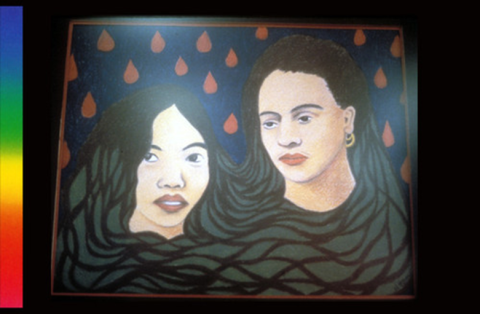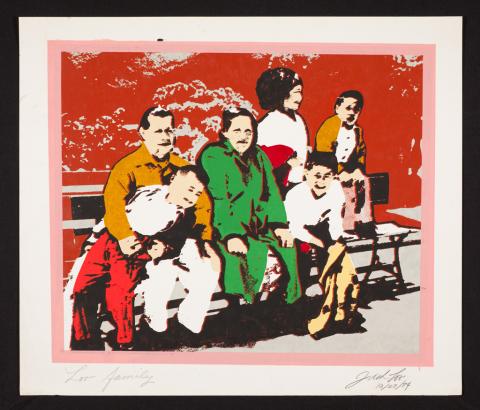Asian American History

Image: Isuda Ti Immuna "they who were first,” Kearny Street Workshop Archives, CEMA 33. Special Research Collections, UCSB Library, University of California, Santa Barbara. Permission to reuse in digital or printed form requires permission to publish from Special Research Collections, UCSB Library.
Asian American history is fundamental and foundational for the field of Asian American Studies. Sucheng Chan, the founder of our Department, was a leading scholar in Asian American history, and her books have remained some of the most important in our field. Professors Xiaojian Zhao, John Park, and Diane Fujino have continued working in Asian American History for most of their time here at UCSB. Professor Xiaojian Zhao received her Ph.D. in History from UC Berkeley, and she is among the most prominent scholars in Chinese American History. John Park is a legal historian, he specializes in immigration law and policy, and all of his books have drawn from archival collections in comparative ethnic studies, American legal history, and American immigration history. Diane Fujino has published extensively on social movement history, both in Asian American and comparative ethnic studies.
For students, the Department offers an extensive set of courses in Asian American History, both as general introductions to the field, as well as advanced courses for students interested in more detailed areas, including courses on Western colonialism and migration, Asian American oral histories, and family and community histories. Many of our graduates have pursued advanced studies in Asian American history after college, and we welcome all students as they explore with us the innovative methodological and substantive approaches to this field.
Literature and Cultural Studies

Image: WACC presents Marrón and Taiko Dojo, Kearny Street Workshop Archives, CEMA 33. Special Research Collections, UCSB Library, University of California, Santa Barbara. Permission to reuse in digital or printed form requires permission to publish from Special Research Collections, UCSB Library.
Structural forms of inequality have appeared throughout all forms of art and cultural production, and artists and writers have challenged structural inequalities across every conceivable media. Professor erin Ninh has published an award-winning book about Asian American literature, about the ways in which Asian American women writers especially have understood their position in Asian American families and in American society. Professor Sameer Pandya’s scholarly and creative works have explored issues of South Asian American identity—his protagonists want to belong, even as their struggles leave them unsettled, to the point where they find themselves unsettling. Professor Cho’s work explores how Asian American artists and performers have tried to carve a distinctive place for themselves through art, performance, and material culture.
All of their courses offer a breathtaking range of approaches in literary and cultural studies. Students in the introductory classes develop a fine sense for close readings of texts and for conceptual ways of understanding important themes in novels, films, and other creative productions. The upper division courses offer more refined ways of seeing—students will develop a finer aesthetic sensibility, as well as an expansive vocabulary to discuss and to understand media in all of its variety.
Gender & Sexuality

Image: International Women's Day, Kearny Street Workshop Archives, CEMA 33. Special Research Collections, UCSB Library, University of California, Santa Barbara.
Permission to reuse in digital or printed form requires permission to publish from Special Reserach Collections, UCSB Library.
In the last five decades, scholars in the humanities and social sciences have investigated and redefined categories that were once thought to be fixed, permanent, and “natural.” If our understanding of “race” has changed fundamentally, from something fixed, permanent, and “natural,” to something much more fluid, relational, and social, then so have our understandings of gender and sexuality. Scholars in our Department have published important works that have not only illustrated the gendered dimensions of past social and legal practices, but also underscore the dynamic, performative nature of “masculine” and “feminine,” of “male” and “female,” and of what it means to be “heteronormative” and to be “queer.”
Professor erin Ninh uses feminist analyses to examine the subtleties of power, harm and subject formation in Asian American literature, families and migration, and mental health. Professor Lisa Park teaches classes that study social policy’s impact on women of color. Professor Lalaie Ameeriar studies and teaches topics about racialized gender, labor, and the state. Incoming Professor Alexander Cho’s classes are about how Asian Americans are challenging conventional norms of gender and sexuality. Professors Xiaojian Zhao and Diane Fujino offer courses that explore the gendered dimensions of Asian American history. By taking many of these classes, students will be well-prepared for advanced studies in racialized gender and sexuality.
Social Movements & Environmental Justice

Image: Fight for decent low rent housing, Kearny Street Workshop Archives, CEMA 33. Special Research Collections, UCSB Library, University of California, Santa Barbara. Permission to reuse in digital or printed form requires permission to publish from Special Research Collections, UCSB Library.
How do people facing horrible circumstances come to organize with one another, and then to take upon themselves the responsibility to change those very circumstances? The study of social movements is in a profound way the study of how people found and strengthened one another, how they shared resources and then built new methods to change their conditions, and how their activities made our societies more just in spite of intense resistance to their efforts. In Asian American Studies, historical accounts of social movements and of community building explain the very existence of our field, including our Department—that is, without activism, without Asian Americans coming together and demanding an intellectual space within the University, we simply wouldn’t have a Department of Asian American Studies.
Professor Diane Fujino is a leading scholar of social movements, including those Asian American social movements that were so transformative in the postwar period. Her lower and upper division classes consistently attract a new generations of students interested not just in studies of how communities of conscience got together and made changes in the past, but of how to continue making such spaces on our campus and beyond. Professor Cho offers classes that show how art and performance can serve and further activism, how they can be an integral part of progressive community-making. Professor Lisa Park’s research examines the intersections of migration and environmental justice movements.
Comparative Ethnic Studies

Image: (title unknown), Galeria De La Raza archives, CEMA 4, Special Research Collections, UCSB Library, University of California, Santa Barbara. Permission to resuse in digital or priented form requires permission to publish from the Sepcial Research Collections, UCSB Library.
Scholars in Asian American Studies have always been in conversation with scholars in Black Studies, Chicano and Chicana Studies, Native American Studies, and Feminist Studies, as well as scholars working in race and ethnicity across more traditional departments in the social sciences and in the humanities. Scholars in comparative ethnic studies have shown, through their research, how law and social norms have cut across racial, ethnic, and gendered groups, denying a range of people their dignity based on race, ethnicity, migration status, gender, sexuality, and disability. These scholars have also shown how, in turn, people have organized across these differences, to resist unjust and unfair conditions by forming powerful alliances. Professor Diane Fujino’s research has focused on cross-racial solidarities, especially between African Americans and Asian Americans. Professor Lisa Park has explored how environmental and social policies have impacted a broad range of vulnerable groups, and Professor John Park has published work that shows, in similar ways, how immigration rules continue to shape inequality in the United States.
Many of our courses in the Department reflect approaches common in comparative ethnic studies. In addition to Asian Americans, we study the impact of law and policy and structural racism on African Americans, Native Americans, and Chicano and Chicanos. By including and illuminating the experiences of other people of color, we stress how oppressed people often share common problems, and by highlighting how we can work together, we teach students the importance of coalition building and collective problem solving.
Immigration and Citizenship

Image: Loo Family, Kearny Street Workshop Archives, CEMA 33. Special Research Collections, UCSB Library, University of California, Santa Barbara. Permission to reuse in digital or printed form requires permission to publish from Special Research Collections, UCSB Library.
In the late 19th century, persons of European ancestry insisted that persons of Asian ancestry were “unfit” for American citizenship, as they were “unassimilable” into European American norms and customs. Asians faced exclusion from immigration. Moreover, the United States did not allow immigrants in Asia to pass into American citizenship until 1952. And even after hundreds of thousands of Asian immigrants and native-born Asian Americans had formal citizenship, they still appeared as “perpetually foreign” to the fellow European Americans who gazed upon them. These themes appear prominently in Asian American history and Asian American cultural studies, and Professors Xiaojian Zhao on Chinese American immigration, John Park on legal and race theory and migration, Lalaie Ameeriar on the state and immigration, and Sameer Pandya in creative writing have explored these themes extensively in their published works. Professors Lisa Park through public policy and healthcare access and Diane Fujino through social movements examine the ways immigrants and communities of color are excluded from the rights and protections of citizenship, as well as the ways inclusion too can also be problematic, including the ways that inclusion for one group can and has been premised on the exclusion of others.
Several of our upper division classes offer detailed historical accounts of how the United States regulated immigration and citizenship. These classes offer detailed studies of how Americans have conceived of “immigrants,” “citizens,” “aliens,” and “foreigners” over time. In his classes in cultural studies and in creative fiction, Professor Pandya shows how Asian Americans can experience “foreignness” and American citizenship at the same time.